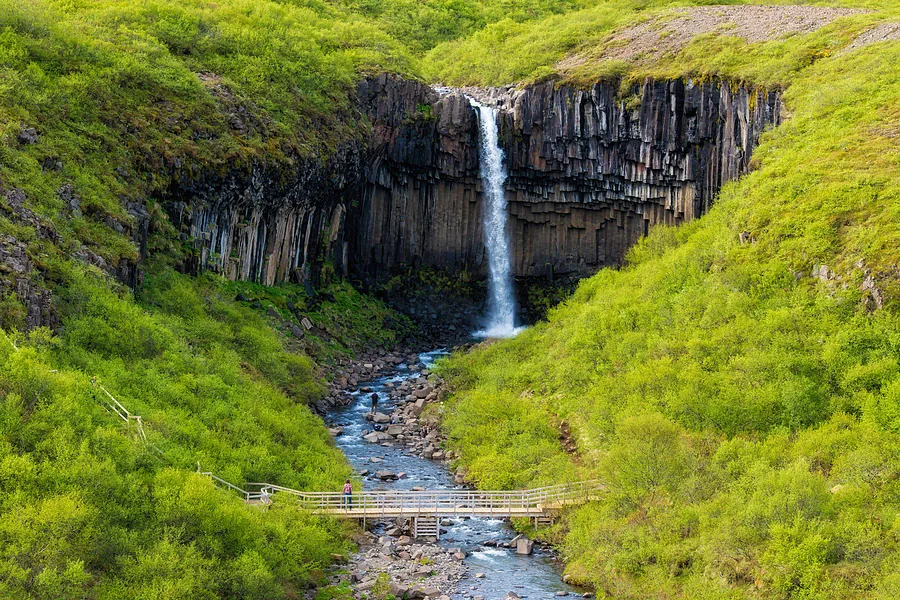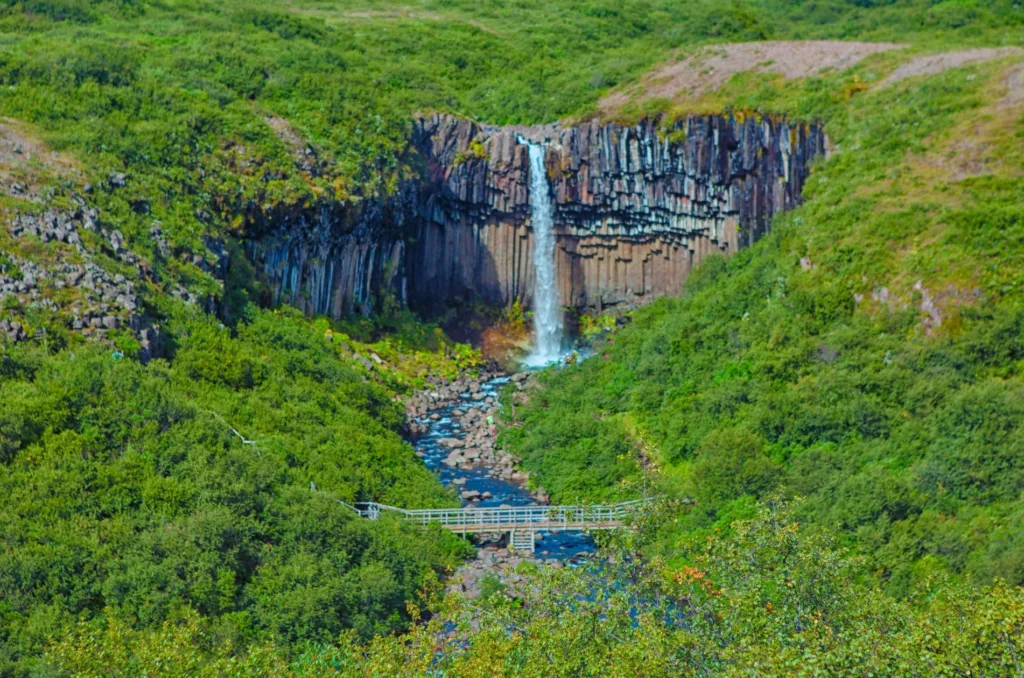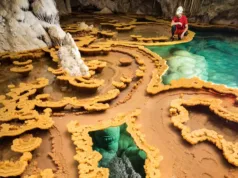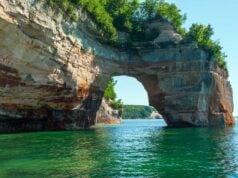Svartifoss is a captivating waterfall located in Vatnajökull National Park, in the southern region of Iceland. It is one of the country’s most iconic and picturesque waterfalls, renowned for its unique and striking appearance. The name “Svartifoss” translates to “Black Falls” in Icelandic, derived from the dark basalt columns that surround and accentuate the waterfall.


The main attraction of Svartifoss lies in its distinct geological features. The waterfall cascades over a stunning cliff face composed of black basalt columns, which were formed by the cooling of lava that once flowed in the area. These hexagonal basalt columns create a mesmerizing visual spectacle, resembling a wall of organ pipes or stacked crystals, adding to the allure of the waterfall.
The contrast between the dark basalt formations and the white water plunging down the cliff makes Svartifoss a captivating sight to behold. The surrounding scenery is equally impressive, with dramatic landscapes, lush vegetation, and imposing glaciers, adding to the beauty of the site.
To reach Svartifoss, visitors typically embark on a hiking trail within Vatnajökull National Park. The hike takes you through picturesque Icelandic nature and unveils stunning views of the waterfall as you approach it. The journey allows you to appreciate the natural beauty of the region and immerse yourself in the tranquility of the landscape.
Svartifoss is not only a popular destination for tourists seeking natural wonders but also a significant site for geologists and nature enthusiasts who appreciate the geological history and formation of these unique basalt columns.
As with any outdoor adventure, it is essential to follow safety guidelines and respect the environment when visiting Svartifoss and its surroundings. Proper preparation and adherence to park regulations will ensure that visitors can enjoy the splendor of this Icelandic gem while preserving its beauty for generations to come.
Formation of Svartifoss

The formation of Svartifoss can be attributed to a fascinating geological process that took place over thousands of years. The key factor in the waterfall’s unique appearance lies in the type of rock it flows over and the specific way in which that rock was formed.
Svartifoss is situated in an area of Iceland known for its volcanic activity, which has contributed to the diverse landscapes found throughout the country. The waterfall is located within Vatnajökull National Park, an area that was shaped by both glacial and volcanic forces.
The rock formation that gives Svartifoss its distinctive appearance is basalt. Basalt is a type of volcanic rock that is commonly formed when lava cools and solidifies. What makes this particular basalt formation so extraordinary are the columnar joints that developed as the lava cooled.
When molten lava flows from a volcano, it undergoes a process of cooling, causing it to contract and crack. As the lava cools, it contracts unevenly, forming cracks that progress vertically and result in the formation of these hexagonal basalt columns. The columns are essentially a result of the lava’s cooling pattern, which fractures the rock into these geometric shapes.
Over time, erosion played a significant role in shaping the landscape around Svartifoss. The force of water flowing from the glacier above and from rainfall gradually eroded the surrounding softer rock layers, leaving the more resistant basalt columns exposed. This process led to the creation of the dramatic cliff face over which the waterfall plunges.
The combination of the volcanic activity that produced the basalt rock and the erosional forces shaping the landscape ultimately led to the formation of Svartifoss as we see it today—a captivating waterfall cascading over a wall of striking hexagonal basalt columns.
The uniqueness of Svartifoss’ appearance has made it one of Iceland’s most iconic landmarks and a must-visit destination for nature enthusiasts and travelers from around the world.
Natural Surroundings and Landscape

The natural surroundings and landscape surrounding Svartifoss are truly awe-inspiring, offering visitors a glimpse into the raw beauty of Iceland’s diverse and captivating wilderness. Situated in Vatnajökull National Park, the area boasts a harmonious blend of glacial features, volcanic formations, lush vegetation, and breathtaking vistas. Here are some of the prominent aspects of the natural surroundings and landscape of Svartifoss:
- Glaciers: Vatnajökull National Park is home to Vatnajökull, Iceland’s largest and most voluminous glacier. The glacier covers a vast area, and its ice cap feeds numerous glacial outlets and rivers, creating a striking contrast with the surrounding black basalt columns and lush vegetation.
- Basalt Columns: As mentioned earlier, the black basalt columns are the defining geological feature of Svartifoss. These hexagonal columns stand tall and proud, creating a unique backdrop for the waterfall. They form a wall-like cliff face that adds to the drama and allure of the landscape.
- Vegetation: The area around Svartifoss is relatively green and lush, especially during the summer months. Moss-covered rocks, grassy fields, and pockets of vegetation thrive in the moist and fertile environment, adding color and vibrancy to the otherwise dark and rugged landscape.
- Hiking Trails: To reach Svartifoss, visitors typically embark on hiking trails within Vatnajökull National Park. These trails wind through picturesque landscapes, providing hikers with breathtaking views of glaciers, mountains, and other unique geological formations.
- Wildlife: The national park is home to various wildlife species, including birds, reindeer, and Arctic foxes. Observing these animals in their natural habitat is a thrilling experience for wildlife enthusiasts.
- Rivers and Streams: The glacier’s meltwater feeds numerous rivers and streams that wind through the park. The flowing water adds an element of serenity to the surroundings and contributes to the formation of the waterfalls like Svartifoss.
- Mountain Scenery: The landscape is dotted with rugged mountains, adding a sense of grandeur and scale to the surroundings. These mountains, combined with the glaciers, create a striking contrast against the dark basalt formations and lush valleys.
Overall, the natural surroundings and landscape of Svartifoss are a testament to the geological forces that have shaped Iceland over millennia. The combination of glaciers, volcanic features, basalt columns, and diverse flora and fauna makes this area a must-visit destination for anyone seeking to immerse themselves in the unspoiled beauty of Iceland’s wilderness.
Tourism and Visitor Information

Tourism around Svartifoss and the Vatnajökull National Park has grown significantly in recent years due to the area’s natural beauty and unique geological features. Here is some essential visitor information for those planning to explore Svartifoss and its surroundings:
- Location: Svartifoss is located in Vatnajökull National Park, in the southern part of Iceland. The park is vast and covers a significant portion of the southeastern region of the country.
- Access: To reach Svartifoss, visitors typically start their journey from the Skaftafell Visitor Center, which serves as the primary entrance to Vatnajökull National Park. From the visitor center, there are well-marked hiking trails that lead to Svartifoss. The hike is moderate in difficulty and takes about 1.5 to 2 hours round-trip, depending on the chosen trail and walking pace.
- Weather: Iceland’s weather can be unpredictable, and conditions around Svartifoss can change rapidly. It is essential to be prepared for various weather conditions, including rain, wind, and even snow, especially during the shoulder seasons and winter months. Dress in layers and bring waterproof clothing and sturdy hiking boots.
- Best Time to Visit: The best time to visit Svartifoss and Vatnajökull National Park is during the summer months (June to August) when the weather is milder and the hiking trails are more accessible. However, this period is also the peak tourist season, so expect more crowds. If you prefer a quieter experience, consider visiting during the shoulder seasons of spring (April to May) or autumn (September to October).
- Facilities: The Skaftafell Visitor Center provides essential amenities, including restrooms, information about the area, and sometimes exhibits. However, the facilities are limited along the hiking trails, so make sure to bring enough water and snacks for your hike.
- Guided Tours: For those who prefer a guided experience or want to learn more about the geological and natural history of the area, guided tours are available. Local tour operators offer various guided hikes and glacier tours, allowing visitors to explore the region with the expertise of knowledgeable guides.
- Safety: While Svartifoss and its surroundings are incredibly beautiful, it’s crucial to prioritize safety during your visit. Stick to marked trails, follow park regulations, and pay attention to weather warnings. The terrain can be uneven and slippery, so watch your step and stay away from the edges of cliffs or steep drops.
- Environmental Respect: Vatnajökull National Park is a protected area, and it is essential to respect the environment and leave no trace of your visit. Avoid leaving any trash behind and be mindful of wildlife and fragile vegetation.
By being well-prepared and respectful of the natural environment, visitors can fully appreciate the breathtaking beauty of Svartifoss and the surrounding landscapes while ensuring the preservation of this stunning Icelandic treasure for future generations to enjoy.




































